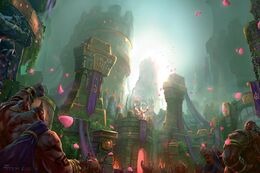Goria
 | |
| Type | Capital, port city |
| Population | Several thousands |
| Leader(s) |
|
| Government | Imperator |
| Race(s) |
|
| Affiliation(s) | Gorian Empire |
| Location | Northwestern Talador |
| Status |
Completely destroyed Shattrath City built in its place |
Goria ("Throne of the King" in the ogre language)[1] was the ancient capital of the ogres and the Gorian Empire up until around 400 years before the opening of the Dark Portal. Nestled near several hills, the city had thousands of inhabitants and an ocean port.[2] It was built on former Apexis arakkoa territory,[1] and later the draenei would build Shattrath City in the same location.[3]
History
The place where Goria stood once belonged to the Apexis arakkoa. Two hundred years after the fall of the Apexis, a group attempted to search for Apexis Crystals and other artifacts in the ruins, but they were occupied by the ogron and their ogre slaves. The ogron could not be reasoned with, but the arakkoa taught the ogres the way of arcane magic and the slaves staged a rebellion. The city became known as Goria, but when the arakkoa attempted to take the Apexis relics, the ogres fought them off. Now sorcerers themselves, the ogres did not want to give up any potential source of power. The first ogre the arakkoa taught, and Goria's first king, was Gorgog the Gronnslayer.[1]
During a great war between the ogres and the orcs, the latter laid siege to Goria. Seeing no reason to waste countless lives in an attempt to break down the city's significant fortifications, the orcs were content to keep their distance on the surrounding hills and starve out their enemey. The Gorians believed they could outlast any siege thanks to their ocean port. Due to the tumultuous state of the elements, the orcish shaman were not as effective in calling on their powers as they once had been.[2]
However, as the months passed, the ogres found themselves unable to maintain their empire. Trade via the ocean was not enough; the ogres needed access to their network of land-based trade routes, which the orcs had severed. Imperator Molok and his sorcerers revisited their Apexis crystals, searching for a way to break the siege. In time, they discovered the arakkoan legend about the Curse of Sethe, and began experimenting with ways to create a similar affliction among the orcs. They succeeded, and soon the so-called red pox spread like wildfire through the orcs' encampments, culling vast amounts of the orcish combatants.[2]
The orc Nelgarm and his fellow shaman, realizing that the pox was an unseen attack from the ogres and that the siege was now doomed to fail, beseeched the elements to destroy Goria. The orcs and the elemental spirits both understood that Molok would resume meddling with the Throne of the Elements if the orcs failed, and so the elements agreed to unleash their fury upon Goria. The shaman gathered outside the ogre city's mighty walls and witnessed the fury of the spirits. What happened next would never be forgotten. A roaring storm churned above the city as the ground groaned and trembled. Over several hours, lightning, fire and earthquakes ravaged the city, bringing down every wall and building, sealing off the escape routes and burning the ships in the harbor. When nothing but ash and rubble remained, the earth itself wrenched open like a giant maw to swallow Molok and the remains of his great city whole.[2]
Untold thousands of ogres died that day; none were left alive by the elementals. Only whispers of the event would reach the other Gorian cities and outposts, but those whispers would be enough to discourage any further tampering with the elements. The orcs were victorious, but they had suffered massive losses and witnessed a destructive power they never wanted to see again. Nelgarm and the other shaman were particularly frightened by the elementals' wrath and said that the need for a unified orc army had passed. There was little argument, and the clans returned to their lands.[2]
Two hundred years after Goria was destroyed, the draenei arrived and built Shattrath City in the location where the city once stood.[3] When the draenei did so, there was an explosion of anger within Highmaul, the new ogre capital. It was seen as a unforgivable insult for these small, weak newcomers to build a city on the bones of the Gorian Empire's great capital, but Shattrath's sleek construction and otherworldly defenses gave the ogres pause. Nothing like their technology had ever been seen on Draenor before, and even their weakest apprentices had more refined and effective magical techniques than even the most advanced ogre sorcerers.
Imperator Hok'lon seized control of Highmaul and declared that he would reclaim Shattrath from the "usurpers". He promised that Highmaul would become the center of a new, enlightened Gorian Empire once the draenei had been slaughtered. Highmaul's aristocracy threw their suppot behind Hok'lon, and the ogre army marched on Shattrath. Despite the ogres' greater numbers, the city's defenses easily repelled their first — and only — attack. As the ogres regrouped, the draenei launched surprise attacks from multiple directions, killing Hok'lon and his generals and leaving the ogres in disarray. The draenei then immediately returned to Shattrath as their leader, Velen, appeared on the city's ramparts and told the ogres, "Go home, and you will not be harmed." The ogres fled, the grandiose war that was meant to revive the Gorian Empire having ended after a single attack. The Highmaul ogres never attempted a frontal assault on the draenei again.[4]
References
- ^ a b c World of Warcraft: Chronicle Volume 2, pg. 37-38
- ^ a b c d e World of Warcraft: Chronicle Volume 2, pg. 49
- ^ a b World of Warcraft: Chronicle Volume 2, pg. 53
- ^ World of Warcraft: Chronicle Volume 2, pg. 56
